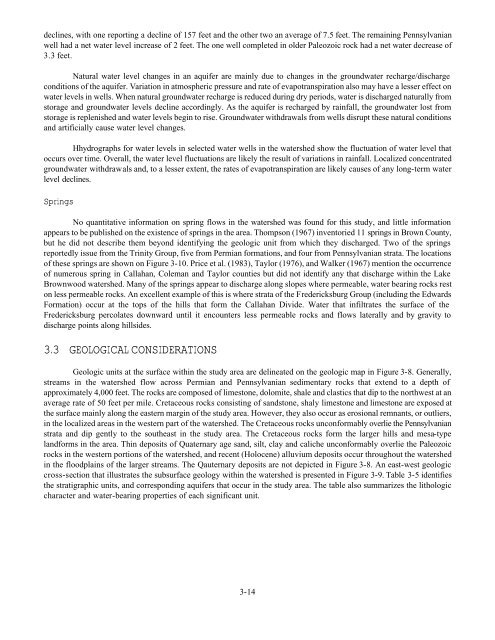Lake Brownwood Watershed - Texas State Soil and Water ...
Lake Brownwood Watershed - Texas State Soil and Water ...
Lake Brownwood Watershed - Texas State Soil and Water ...
Create successful ePaper yourself
Turn your PDF publications into a flip-book with our unique Google optimized e-Paper software.
declines, with one reporting a decline of 157 feet <strong>and</strong> the other two an average of 7.5 feet. The remaining Pennsylvanian<br />
well had a net water level increase of 2 feet. The one well completed in older Paleozoic rock had a net water decrease of<br />
3.3 feet.<br />
Natural water level changes in an aquifer are mainly due to changes in the groundwater recharge/discharge<br />
conditions of the aquifer. Variation in atmospheric pressure <strong>and</strong> rate of evapotranspiration also may have a lesser effect on<br />
water levels in wells. When natural groundwater recharge is reduced during dry periods, water is discharged naturally from<br />
storage <strong>and</strong> groundwater levels decline accordingly. As the aquifer is recharged by rainfall, the groundwater lost from<br />
storage is replenished <strong>and</strong> water levels begin to rise. Groundwater withdrawals from wells disrupt these natural conditions<br />
<strong>and</strong> artificially cause water level changes.<br />
Hhydrographs for water levels in selected water wells in the watershed show the fluctuation of water level that<br />
occurs over time. Overall, the water level fluctuations are likely the result of variations in rainfall. Localized concentrated<br />
groundwater withdrawals <strong>and</strong>, to a lesser extent, the rates of evapotranspiration are likely causes of any long-term water<br />
level declines.<br />
Springs<br />
No quantitative information on spring flows in the watershed was found for this study, <strong>and</strong> little information<br />
appears to be published on the existence of springs in the area. Thompson (1967) inventoried 11 springs in Brown County,<br />
but he did not describe them beyond identifying the geologic unit from which they discharged. Two of the springs<br />
reportedly issue from the Trinity Group, five from Permian formations, <strong>and</strong> four from Pennsylvanian strata. The locations<br />
of these springs are shown on Figure 3-10. Price et al. (1983), Taylor (1976), <strong>and</strong> Walker (1967) mention the occurrence<br />
of numerous spring in Callahan, Coleman <strong>and</strong> Taylor counties but did not identify any that discharge within the <strong>Lake</strong><br />
<strong>Brownwood</strong> watershed. Many of the springs appear to discharge along slopes where permeable, water bearing rocks rest<br />
on less permeable rocks. An excellent example of this is where strata of the Fredericksburg Group (including the Edwards<br />
Formation) occur at the tops of the hills that form the Callahan Divide. <strong>Water</strong> that infiltrates the surface of the<br />
Fredericksburg percolates downward until it encounters less permeable rocks <strong>and</strong> flows laterally <strong>and</strong> by gravity to<br />
discharge points along hillsides.<br />
3.3 GEOLOGICAL CONSIDERATIONS<br />
Geologic units at the surface within the study area are delineated on the geologic map in Figure 3-8. Generally,<br />
streams in the watershed flow across Permian <strong>and</strong> Pennsylvanian sedimentary rocks that extend to a depth of<br />
approximately 4,000 feet. The rocks are composed of limestone, dolomite, shale <strong>and</strong> clastics that dip to the northwest at an<br />
average rate of 50 feet per mile. Cretaceous rocks consisting of s<strong>and</strong>stone, shaly limestone <strong>and</strong> limestone are exposed at<br />
the surface mainly along the eastern margin of the study area. However, they also occur as erosional remnants, or outliers,<br />
in the localized areas in the western part of the watershed. The Cretaceous rocks unconformably overlie the Pennsylvanian<br />
strata <strong>and</strong> dip gently to the southeast in the study area. The Cretaceous rocks form the larger hills <strong>and</strong> mesa-type<br />
l<strong>and</strong>forms in the area. Thin deposits of Quaternary age s<strong>and</strong>, silt, clay <strong>and</strong> caliche unconformably overlie the Paleozoic<br />
rocks in the western portions of the watershed, <strong>and</strong> recent (Holocene) alluvium deposits occur throughout the watershed<br />
in the floodplains of the larger streams. The Qauternary deposits are not depicted in Figure 3-8. An east-west geologic<br />
cross-section that illustrates the subsurface geology within the watershed is presented in Figure 3-9. Table 3-5 identifies<br />
the stratigraphic units, <strong>and</strong> corresponding aquifers that occur in the study area. The table also summarizes the lithologic<br />
character <strong>and</strong> water-bearing properties of each significant unit.<br />
3-14



